Editor’s note: This text-based course is an edited transcript of the webinar, Interpreting Your CLASS Scores, presented by Jennifer Rosenbaum, BS, MEd.
Learning Outcomes
After this course, participants will be able to:
- Explain what the CLASS measures.
- Interpret CLASS scores.
- Plan next steps to refine their practice based on CLASS.
We will be spending our time today diving deep into the CLASS, which is the Classroom Assessment Scoring System. If you have your own CLASS scores and have received an observation from your school or from your district, feel free to grab those. You will be able to use them as we get going into the content. If you haven't gotten CLASS observed or you don't have access to your scores, that's fine. You will be able to work through and learn as we go with some sample scores. Today we will talk about what the CLASS is, what observers are looking for, how observations are structured, what your scores actually mean, and how you can use your scores.
What is CLASS?
- Research-proven
- Valid
- Reliable
CLASS stands for the Classroom Assessment Scoring System. It is an observation tool that is designed to look specifically at interactions that are happening in the classroom. It is published by Teachstone and is used nationally. Every Head Start program is assessed using the CLASS and many school district pre-K programs and state pre-K programs are assessed using the CLASS.
What is unique about this tool as opposed to some other observation tools or assessment tools that you might have experience with in your classroom is that this really focuses on the people. It focuses on the interaction and captures the complexity of the relationships in your room. We all know that a pre-K classroom is so much more than simply the amount of materials you have or the specific curriculum that you use. It is really about those relationships, and CLASS is designed to look at that and capture that and give you feedback about it. It is a tool that is used most heavily in pre-K classrooms, but there are versions of it that are available for infants through 12th graders, so you can use it across a child's educational career or the span of schools within a district. Today, we are going to hone in on the pre-K CLASS tool, which is designed to be used with children ages three to five.
The CLASS is research-proven. It has been used in thousands of classrooms across various settings, from home-based programs to center-based and school-based programs. It is curriculum agnostic, so it does not matter what your instructional approach is, CLASS can be used with any curriculum in any setting. This makes it a really helpful tool to be used across entire districts or states. It is a reliable tool, so every person who comes in and does a CLASS observation goes through rigorous two-day training and has to pass a reliability test. That means that if I were to come into your room and do a CLASS observation, and someone else were to come into your room and do a CLASS observation, we would come out with the same scores. That is really important because we do not want observer variability to impact the feedback that you are getting about the relationships and the interactions happening in your room.
It is also a valid tool. We know that classrooms that score higher on the CLASS are correlated with classrooms that have higher student outcomes. We all know how hard it can be to measure actual learning outcomes for three, four, and five-year-olds, so it is helpful to have a tool where someone can observe the interactions happening in the room and know that there has been plenty of research done that has correlated the quality of those interactions with the quality of educational outcomes for kids. To summarize, it is a widely used tool that is research-based, valid, and reliable, so we can trust the information that is coming from it. It is not just a subjective view of your classroom.
Why use CLASS?
- Consistent lens for classroom quality
- Reflection
- Coaching
- Accountability
Given all of that, why are districts and states using the CLASS? I have used the CLASS in various settings. Regardless of the setting, I think that the most helpful outcome of it has been developing a consistent lens for looking at classroom quality that goes across settings. If I am in one specific school or one center, it is really helpful for everyone on our team to know what we mean when we say we are looking for high-quality classrooms. If we do not ground that in some common language and a common vision, what I say and what the teacher next door to me says might mean really different things. For example, when we say "really loving and supporting interactions with kids," the CLASS helps us have some shared language around that. This provides a consistent bar for looking at quality all the way up to the state or federal policy level. If I am implementing a state quality rating system and I need to be able to look at all the programs in my state across a consistent lens, the CLASS can help me do that.
Once you have that consistent lens, teachers, administrators, and leaders can do all kinds of things. One of the most important things that I found is it is a really helpful tool for reflection. When teachers understand the CLASS really well, they can reflect and think about their classroom and their practice in a different and deep way which I have found to be powerful and empowering for teachers in the room.
As a coach, I've also seen it to be useful because we can ground our coaching conversations in a shared understanding with that vision for quality. It's not just me telling a teacher they need to do X because I think it's a good idea. It is the CLASS that says high-quality language development looks like this and that has been research-proven, so that is what I am working towards. It is a good way to have some research backing your practice.
The third piece is it can be used for accountability purposes. If programs, teachers, and administrators understand what the tool is, that is much more helpful than just having some arbitrary tool that no one really understands. As I said, there are many different reasons that programs or districts may be using the CLASS, all of which can be incredibly helpful. Generally, the more we know about the tool, the more applicable it can be, and the more we can use it.
Observations
That is the big picture of what the CLASS is. I am going to walk you through a little bit more about what a CLASS observation actually might look, sound, and feel like in case you have not had one or in case you are wondering what happened when you did have one. If you want to know a little bit more about this, Teachstone has a video on their blog that might be helpful to you. In general, the structure for doing a CLASS observation is pretty standardized.
Typically one observer will come into your room, but sometimes there are two. Whenever I come in and do an observation, I always introduce myself, make sure I know who the teachers are, and make sure I have a general lay of the land in terms of where group time happens and what the schedule is. Then I just sit back and watch and take copious notes. Each observation cycle takes about 15 to 20 minutes. I'll watch for 15 to 20 minutes and then I pause, I stop observing, and I code the notes that I've taken. I'll get into a little bit more about what this looks like in a few minutes, but basically, I watch for 15 to 20 minutes, pause, code, and then repeat. A full CLASS observation consists of four to six cycles of this.
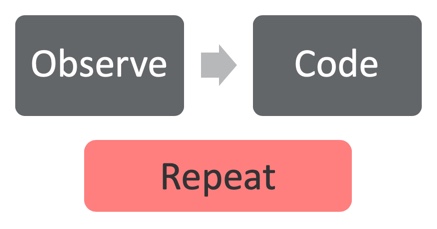
Figure 1. Observation cycle.
The observation cycle, as seen in figure 1, is to observe, code, observe, code, observe, code, observe, code. This will be done at least four times. That means that a CLASS observation typically takes between two to three hours. It includes 20 minutes of observing, it takes about 10 minutes to code, and that is repeated four to six times. The observations typically start first thing in the morning as kids are arriving, and observe pretty much everything that happens in the day. Everything from kids coming in, eating breakfast, going to circle time, and going to centers or some small groups. A CLASS observer watches it all, including the transitions. Remember, we are trying to get a sense of the interactions that are happening in your classroom. Interactions happen all the time, regardless of whether you are in technical teaching mode. Observers will watch everything. The main exceptions that I typically allow for are if a class is going outdoors to recess and it is just going to be too hard to hear individualized interactions. That is an observation I would stop. I have done observations as kids are walking in hallways, as they are transitioning and getting their coats on, and everything in between. Each district may or may not have some slightly different protocols on this, but I would say, by and large, you would expect your observer to be there with you for about two to three hours.
Domains
As the observer watching, I am trying to pay close attention to interactions between teachers and children, and among children. I look at those interactions in three main domains.

Figure 2. Domains of interaction.
Emotional Support
The first domain is emotional support. This is really looking at how strong the relationships are in the classroom. What are the ways in which the teachers are promoting students' social-emotional development? If I am thinking about a person as the CLASS, this is the heart and the feeling. For example, how does this classroom feel when I walk in the door? Is this a warm, supported, happy place where I can tell the kids and teachers are happy to be there and happy to be with each other?
Classroom Organization
The next domain that I look at is classroom organization. This is not about the physical organization of your classroom per se, but it is about how the classroom is structured to promote learning. Are there clear expectations? Are there clear routines and procedures? Are there clear strategies for engagement? Some of the physical layouts may help with this, but it's not measuring the physical environment as a be-all and end-all. It may be using that as a tool towards the broader structures and organization of the classroom. Again, if I am thinking of this analogy of the CLASS as a person, this is like the skeleton, what is holding everything together, and providing the structure. First, we want to make sure kids feel loved and supported, then we want to make sure there is a clear structure so that there are predictability and consistency.
Instructional Support
The last bucket I look at is instructional support. How are teachers actually facilitating learning and development? How are they promoting higher-order thinking and language use? How are they providing feedback to children? Thinking about the body analogy, this is like the brain. This is where learning happens. Instructional support is not necessarily about the content that you are teaching, which curriculum you are using, or which theme you are on. This is about how you are teaching and how you are promoting children's thinking.
I am functionally looking at three different domains. I am thinking about feelings, organization, and intellectual engagement or instructional support. As I am observing, I am taking notes in these domains to figure out how I am going to score the classroom. The other thing that is important to think about as we think about CLASS observations is that as an observer, I am not out to get you in any way. I am not out to just find this one child who is having a horrible day and let that influence everything. As an observer, my goal is to really capture the experience of children in the classroom.
To that end, I am really looking for the average experience of the average child on an average day. I want to capture what most kids experience when they are in this room on most days. I think that is really important if we are going to use this tool for coaching and for feedback. Yes, there is a time and place where we want to problem-solve those individual children or small groups of children who may have different needs from the rest of the group, but by and large, I am thinking about the classroom as a whole. There are other tools that you can use if you are trying to dig deeper into one student or one subset of students, but with the CLASS, I am trying to look at the average experience of the average child on an average day. That is the general approach of how observations work and what observers are looking for.
Scoring
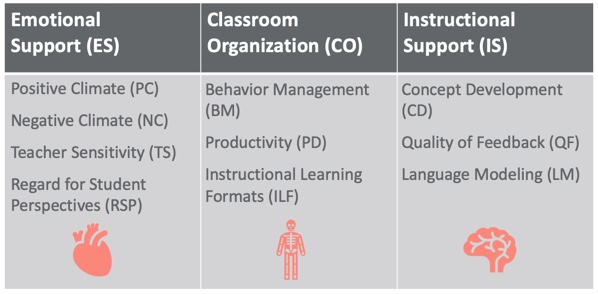
Figure 3. Scoring information.
Once you have an observation, you will get scores in a couple of different areas. As you can see in figure 3, the CLASS has three domains across the top, emotional support, classroom organization, and instructional support. Within each of these domains, there are specific dimensions. Within emotional support, that includes the relationships, but more specifically I am looking at positive climate, negative climate, teacher sensitivity, and regard for student perspectives. In classroom organization, the dimensions are behavior management, productivity, and instructional learning formats. Within instructional support, the dimensions are concept development, quality of feedback, and language modeling.
You will get a score for everything that is listed in figure 3. So you get a total of 10 scores for the dimensions and three scores for the domains. Again, observers have to be reliable, so it doesn't matter who comes into your room, if they watch on the same day and watch the same events, they will come out with the same scores. If you have your own CLASS scores, by all means, look at them now. If you don't, figure 4 shows what some samples scores might look like.
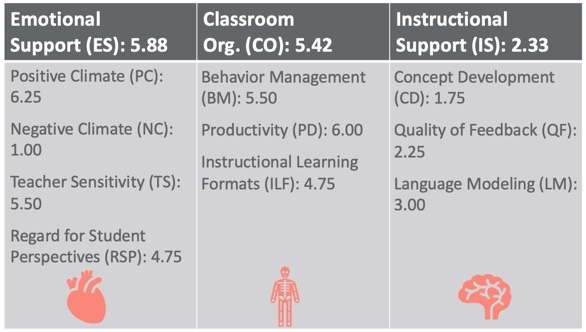
Figure 4. Sample CLASS scores.
All the scores are done on a scale of one through seven. You will notice that the scores at the top of figure 4 are essentially an average of the scores below. For example, the score of 5.88 for Emotional Support is an average of the scores for Positive Climate (6.25), Negative Climate (1.00), Teacher Sensitivity (5.50), and Regard for Student Perspectives (4.75). Observers are watching and taking notes during those 10 minutes where they pause to score. They are translating their notes into numerical scores using the process that they have gone through in their training and they are making those standardized judgments and turning them into numbers.
If you have your own CLASS scores, you may have also received a narrative report. Some programs and districts use narrative reports as well as the scores. There is not necessarily standardization about what those narrative reports do or don't include, so I am not going to get into those too much today other than to say if you have them, read them. They are usually a wealth of information that can help you understand more deeply what the observer saw and how it was coded. You can still do a lot, even if you just have numerical scores.
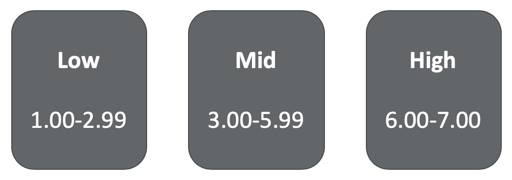
Figure 5. CLASS scoring
As I said, everything is done on a scale of one through seven. Those scores of one through seven are divided into three levels of quality as you can see in figure 5. Low is generally scores that are between a one and a 2.99. In general, if you have a low score, it means that there is limited evidence of effective practices in that domain or dimension. If you have a score between a three and a 5.99, that is a mid-level of quality. With this score, there are some effective practices. Sometimes it happens effectively, but it is not consistent. A high, which is between a six and a seven, indicates that this domain or dimension is happening consistently, effectively, and there is really strong evidence of quality.
If you have your own scores, please take a moment, and using figure 5, go through and highlight where you see low scores, where you see mid scores, and where you see high scores. I suggest using a different color highlighter for each range (low, mid, and high). If you don't have your own scores, use the sample scores in figure 4 and highlight them. For example, in figure 4, is the positive climate score of 6.25 low, mid, or high?
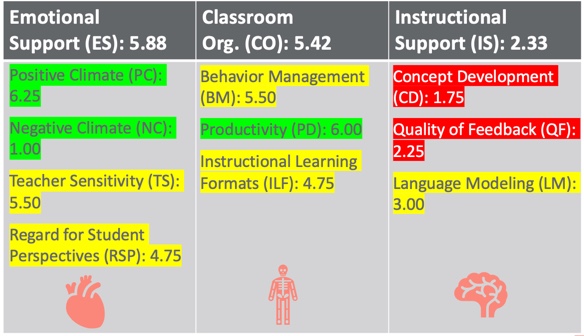
Figure 6. Highlighted sample scores.
If you used the sample scores, you probably came out with something like you see in figure 6 where a positive climate at 6.25 falls into the high range. We will come back to negative climate in a second. Teacher sensitivity at a 5.5 falls into the mid-range. Again, we are using this low, mid, and high criteria. Feel free to take a second and check yours against this if you used the sample scores.
In general, you want to have higher scores. The exception to that rule is with negative climate. As you can see, most of these other dimensions are framed positively, except for negative climate. We don't want a negative climate, we actually want that to be infrequent. That is why a low score in negative climate is actually considered high quality. Remember, a score of one is the lowest you can get. For everything else, we are looking for as close to a seven as we can get.
I always find it really helpful when I receive a score report before I get bogged down with the numbers to go through and do this, either with highlighting or writing high, mid, low. It helps me to see the big picture of where scores are at. It helps to zoom out a little bit and think about the quality.
Using the Data
Now you should understand generally what the tool is, what observers are looking for, and what your scores mean. Next, we are going to think about how to we use those scores. There is a little bit of context that I want to go through before we actually jump in.
As I mentioned, the more you understand about the CLASS and the tool, and the more it becomes a shared vision for quality in your program, the better off you are going to be. If your program has access to resources from Teachstone, such as CLASS manuals, dimension guides, or anything that says CLASS and is from Teachstone, I recommend you pull that out and read it. If you can go through it with someone, that is even better. There are also plenty of resources on their website which I will get into a little bit more as we go. The Teachstone Blog has lots of information about the CLASS tool, about individual domains and dimensions, and what observations to look for.
Before you jump into it saying, "I'm going to focus on this and I think this means that," try to get a sense from Teachstone about what it means because therein lies the power of the tool. When you and I are sitting in a room and we say we are thinking about positive climate, if we can have the same understanding of that, it's going to be even more powerful. Build your background knowledge as much as possible.
You might be thinking, what am I going to do with this data? I have the score report and I have a bunch of numbers, how am I even going to think about using this? Just as with any kind of data, there are infinite ways that you could think about using it and approaching it. The way that I typically think about this and have found to be successful as I have coached teachers is what I am going to explain to you today. However, there may be tweaks or modifications that you want to make for your own unique context.

Figure 7. Using the data.
Figure 7 shows a visual of three things I like to think about when I'm looking at scores. I like to think about the following questions:
- What are my goals?
- What am I going to prioritize to get there?
- How am I actually going to do it and apply my learning?
The first thing I want to think about is my goals. Your program or district may have specific goals. If they do and if you know those goals, I would jot them down on your score report or somewhere handy that you can reference so you can look at your scores in comparison to those goals. If you don't have program goals or you don't know what they are, you can also use what Teachstone calls thresholds for quality, as seen in figure 8.
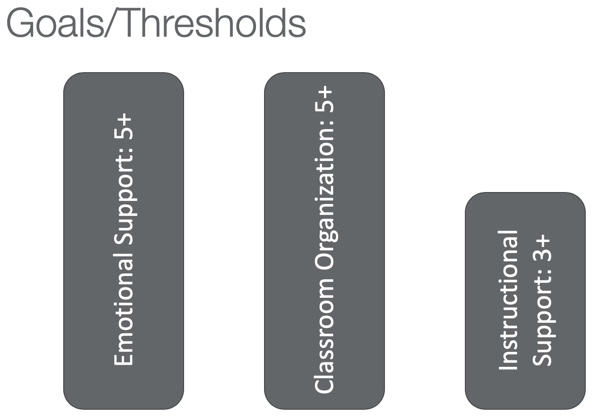
Figure 8. Thresholds for quality.
As I mentioned previously, higher scores on CLASS have been correlated with better student outcomes. These thresholds for quality, as seen in figure 8, are the scores that are sort of the gateways to those stronger student outcomes. If you are scoring at a five or above in emotional support, a five or above in classroom organization, and a three or above in instructional support, those are generally where we see the bumps for students. If you can meet those thresholds, we can feel confident that kids in your classroom are better maximizing their ability to learn. The thing I want you to notice here is that those thresholds aren't the same for each domain.
We talked about emotional support being the feeling of relationships and safety and emotional connectedness in the classroom. That's huge. That has to be in place before kids can even think about learning new vocabulary words. If they don't feel safe and loved and secure in the room they can't learn much, so we want to make sure the emotional support score is strong.
We also want to make sure that the classroom organization score is strong. If there aren't consistent routines and procedures and kids don't know what to expect in the room, it is going to be much, much harder for them to access their learning. If we think about it from a teacher's perspective and from a grown-up perspective, we can support kids' emotions and we can set classroom structures in place and be pretty consistent with those throughout the day.
Yes, it takes intentionality and it takes planning, but we typically have an easier time doing those things than actually supporting the instruction. This is why the instructional support threshold is a little bit lower. It is hard to ask strong open-ended questions all day long. It is much harder to ask strong open-ended questions all day long than it is to smile at children all day long, so we typically see instructional support scores that are lower than emotional support and classroom organization. That is okay for the purposes of student outcomes.
As I said before, if you have some goals that you know of for your specific program, go ahead and use those. If you don't, I would use these thresholds as a guidepost. They are a good starting point for you.
Priority
Once you think about what your goals are, you can think about how to prioritize. In general, I am willing to bet that if you have your own CLASS scores, instructional support is not the highest. I can't think of a classroom's CLASS scores that I have seen where instructional support is the highest. It is the hardest one to do. If you look at national data, it is always the lowest, and by far. I'm willing to bet that that is the case in your room too. That is okay, but don't fall into the trap of saying instructional support is the lowest, I have to start there. I just have to bring this up, it is too low. I need to start here because to my earlier point if kids don't have strong relationships and if the classroom procedures aren't clear, it is going to be 10 times harder to raise those instructional support scores.
We really want to think through how we can build that emotional support first. If my emotional support scores are not meeting either the threshold or the goals that my district has set, I need to start there. Even if I am only half a point away, I still would start here because you are never going to go wrong focusing on emotional support and building up those emotional connections in the room. That is never going to hurt you. Until you feel 100% confident that that isn't a good place, start there, even if the numbers are not the lowest.
Once emotional support is in a good place, and you are meeting the goals or the thresholds, then start to think about classroom organization. Kids feel safe and secure, and now I am thinking about my routines, my procedures, and the way my classroom is structured. This can help increase engagement and set the stage to focus on some instructional pieces. To reiterate, I really want to make sure that these two are in a good place, first emotional support, then classroom organization. If both of these domains are strong and they are meeting the thresholds and my district's bar for quality, then and only then would I move into prioritizing instructional support.
Too many times I have seen teachers say, "Oh, my instructional support scores are really low, so I am just going to work on asking more open-ended questions and using more advanced vocabulary." However, if those other two pieces aren't in place, this just isn't going to go anywhere fast. So as tempting as it is to go here and say, "I really want to be a better teacher, I want to impart more content upon my students and engage them in higher-order thinking," they are not going to engage in higher-order thinking if these two aren't there. So don't fall into the trap of just focusing on instructional support because those scores are low. I would almost always start with emotional support or classroom organization.
If I am looking at the samples scores in figure 6 and thinking about where I would prioritize, here is the metacognitive that I would go through to help myself think about it. I would look at these scores and see, oh no, there is red in instructional support. I have two areas that are really low in that area. Concept development is only a 1.75. Quality of feedback isn't much higher. I really want to make sure that those scores improve, but I know not to fall into that trap because I am not going to be able to work on these if things in emotional support and classroom organization aren't tighter. Let me look at those areas and make sure that I am in a good place.
The first thing I want to do is think about emotional support. I am looking at my positive climate score, and I see it is a 6.25. That is great. That means that it is in the high range, so I feel good about that. Looking at my scores for teacher sensitivity and my regard for student perspectives, I see that those are a little bit lower and in the mid-range. Overall, my emotional support is at a 5.88, which does meet the threshold for quality from Teachstone, but I know that a lot of programs use six as a goal in emotional support. A lot of programs I have worked with have used that as their goal because, again, it is the foundational piece. Now I am thinking, I know I want emotional support to be a little bit higher, even though teacher sensitivity is at a 5.5. Regard for student perspectives is at a 4.75. That is not great. I could potentially go over here to classroom organization, but I would rather hedge my bets and spend a little bit of time thinking about emotional support and getting that into a really strong spot before I move on. If I were looking at these scores and these were mine, I would definitely stick with regard for student perspectives within emotional support as my focus area.
That being said, there is no one right answer to this. This always depends on more factors than just the scores. It is going to depend on if your school as a whole is working on one of these areas and you want to tag onto that. Maybe you have been reading about one of these areas and really know that that is a high leverage area for you. You should think holistically about your practice and about your classroom, but if I were looking only at scores, and these were my scores, I would probably stick in this emotional support range.
If you have your own CLASS scores, go ahead and get those out and look at them now. You have your highs, mids, and lows marked and you have heard my metacognition of how I would walk through my own scores. Take a moment to walk through some of your own scores right now. Think about what you know about goals and/or thresholds and what you know about your own classroom, what are you going to prioritize? Pick either emotional support, classroom organization, or instructional support.
Hopefully, you have picked your domain and not fallen prey to the trap of just picking the lowest score to focus on, but really being strategic and thinking through "I want to make sure that my heart is taken care of, that kids feel good and supported in my classroom, that I have strong structures in place, and that my students' minds are engaged in really higher-order thinking." Now I know where I want to focus. Looking back at the sample scores in figure 6, I am really going to dive into emotional support and think a little bit more about regard for student perspectives in particular, but what does that actually mean?
Learn
If you have some CLASS resources or some resources from Teachstone at your program, by all means, dig into those and see what you can learn about the area that you've prioritized. If you don't or if you want some additional resources, there is a handout for you with some suggested blogs from the Teachstone website. These are a great resource for learning more about the CLASS. The handout provides some general resources that reinforce what I have talked about with the tool today. There are also some resources that focus specifically on each of the domains and dimensions.
For example, I said that one of the things in my sample scores that I would like to work on would be in the area of emotional support. In particular, I want to focus on regard for student perspectives. I might look at the blog post titled Regard for Student Perspectives during Circle Time to really think about what that means during circle time in my classroom. What are some good, concrete examples?
There are also some great blog posts for most of the areas of the CLASS that include real-world examples. They give some very tangible, relatable structures, and some real-world examples from our grown-up life about what the various domains and dimensions look like. If you're trying to understand what regard for student perspectives means, I would start there, or with any of them. You can really learn what teacher sensitivity, productivity, and several of the other terms mean as you're learning about the CLASS. The handout provides just a smattering of the resources. These are some of my personal favorites, but there are many more out there. The link to the blog, in general, is at the top, and you can filter by topics, by CLASS in practice, implementation, or pre-K. You can also do a Google search for "Teachstone blog concept development" and all the resources will come up.
Once you have your own CLASS scores, I would really leverage this as a resource for learning more about whatever focused area you have selected. Once you have your area to focus on, it is important to do a little bit of reading to learn a little bit more about what is included in that area and what that actually means in terms of Teachstone language. Even for some of the classrooms that feel like they know what positive climate means, and it makes sense to them, there are some really specific things that CLASS observers look for. If we are going to have a shared language, it is important that you understand what those terms are. It is even more important for some of the terms that feel like I have an understanding of them, but my understanding may be different from yours. For example, behavior management often comes up as a hot one where people think they know what strong behavior management looks like, but my vision for that and your vision for that and the CLASS's vision for that might be different. We are trying to norm on what CLASS means.

Figure 9. Start Stop Continue Framework.
All that to say, take some time to do some learning and do some research on the blog or with whatever resources you have available to you. Once you do that learning, a framework that I have found to be super helpful when thinking about CLASS scores is the Start Stop Continue Framework, as seen in figure 9. There can be a million things that you feel like you want to do once you have CLASS scores. I have sat with teachers who have said, "Well, I'm going to do this, this, this, this, this, this, and this and this, and tomorrow, I'm going to do this, that and the other." It is a lot, and it can be really overwhelming.
I have found time and time again, if we can just narrow and make some bite-size pieces, it is just going to be so much easier, and we are going to actually get a lot more bang for our buck. I found this tool to be really helpful in terms of thinking about how to actually take action based on my scores. For example, maybe I am thinking about emotional support and about things that I am not doing currently, but that I want to start doing. An example might be every time I see a child crying, I am going to say to that child, "It looks like you're upset." That is not a thing I currently do, but it is a thing that I know based on my reading from the CLASS is really good to validate kids' emotions. That is a thing that I am going to start doing. It is bite-sized, it is manageable, it is very concrete, and I can start that.
Based on what I've learned about the CLASS, something I want to stop doing is not supporting quality interactions in my classroom. Again, I am looking at things that are small and bite-sized. If I am thinking about emotional support, a thing I might want to stop doing is telling kids, "You're okay, stop crying," if I see them upset. I know that dismissing kids' emotions is not useful and is not going to increase my CLASS scores. It is not going to build those trusting relationships in my room, so that is a thing I am going to stop. Again, it is small and it is bite-sized.
If I am talking about this conversation with my coach or with my co-teacher, it is something that they can watch for and help hold me accountable with. I also want to think about what I am doing that is really good that I want to continue. I want to grow my practice and really hold this up as something that I have started doing that I want to keep up. In that case, I really want to make sure that when I see two kids in a conflict that I take time to listen to both of them. I ask, "What's going on here?" and I really listen to both children. That is something I have been doing and that is something that I know, again, based on my learning about CLASS and emotional support, that will continue to yield really good results in my classroom and really foster those relationships.
Now I have boiled down three things.
- Something I can start doing that is new to me
- Something I want to stop doing that I currently am doing but I don't want to do anymore
- Something that I want to continue to do that I know I do occasionally or with some regularity
You will notice that I did all three of these within my focus area because that narrow focus is going to help me get the most bang for my buck. I did not want to pull from all different domains or content areas. I really wanted to think clearly about one. In this case, I picked emotional support, and everything I think about, stop, start, or continue is going to come from here. That is going to be a much higher impact in my experience than trying to pick across all three.
If you have your own CLASS scores, take a moment, and think about what your start, stop, and continue might be given what you have seen your scores at now. I would really encourage you to think about just one in each. I know as teachers, we have a tendency to try to want to do everything at once. If you find it helpful to make the laundry list and then prioritize from there, that's fine, but I want you to walk away with only three things, one start, one stop, and one continue because that is how you are really going to be able to see the biggest bang for your buck. Take a minute and do that for yourself. Write them in a place that is easy for you to see and reference, and think about if there is anyone that you want to talk to as an accountability partner, maybe it is your co-teacher or a coach that can really help you implement this.
Once you have done that, you have taken the first step. You really want to make sure that you keep it up. You are probably going to get CLASS scores relatively infrequently. Many programs do them once a year. The reality is we all know that as teachers, we don't want to just reflect on our classrooms once a year we want to reflect constantly. Thinking about how you can help make this live in your work and in your day-to-day is a really important step of using CLASS effectively in your practice. Think about these questions:
- Who could be your accountability partner?
- Where can you do some more learning or some more reading?
- How can you get feedback?
- Can you video yourself?
- Can you ask someone to come in?
- Can you do some more reflection?
Whatever it needs to be, really think about how you can make this live in your practice. I again would encourage you to go to the Teachstone website, look at those blogs that we have highlighted in the handout, and look at the website for additional resources to build your knowledge and understanding. Remember, the better and deeper your understanding of the tool, the better. We have talked about what the CLASS is, what observers are looking for, how to interpret your scores, and how to actually use them to drive your practice. If you want additional resources or have additional questions, feel free to email me.
References
Citation
Rosenbaum, J. (2019). Interpreting Your CLASS Scores. continued.com - Early Childhood Education, Article 23397. Retrieved from www.continued.com/early-childhood-education
